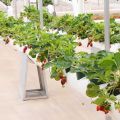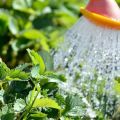Agrotechnics of planting strawberries in high beds according to Finnish cultivation technology
It is difficult to achieve high yields of heat-loving crops in regions with short summers. However, the organization of high beds for strawberries using Finnish growing technology allows this to be done. This method involves the use of a covering material, due to which the soil warms up faster, and the culture ripens earlier and takes root better.
Basic principles of cultivation
To grow a crop using Finnish agricultural technology, you will need to purchase a special covering material that provides mulching of the plant.The cultivation method allows you to collect the first crop 7-8 weeks after planting.
This rate of appearance of ripe berries is explained by the fact that due to the covering material, the soil warms up faster. Also, this method protects the plant from pests and prevents the growth of weeds.
It is possible to achieve high yields with the help of Finnish technology provided that early-maturing strawberry varieties are used. It is also important to follow the principles of planting. The culture in the garden should be placed at a distance of 25-30 centimeters.
Advantages and disadvantages of the method
Finnish agricultural technology has several advantages over traditional methods:
- a favorable nutrient medium is created due to the accumulation of nitrate nitrogen in the upper soil layer;
- the activity of microorganisms that ensure plant growth increases;
- there are no weeds;
- a stable level of humidity is ensured;
- rooting of outlets is prevented;
- the presentation of the berries is preserved, since the fruits are not in contact with the ground;
- the soil warms up evenly.
The only drawback of the method is that for cultivation using this technology, you will need black plastic wrap, which is produced in Finland.
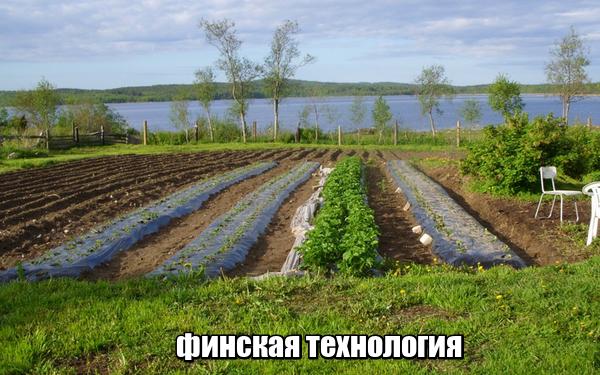
What is needed for the Finnish method?
According to Finnish technology, strawberries are planted in one or two rows. In both cases, a black film (mulch coating) with a width of 1 and 1.2-1.3 meters, respectively, is used. It is this material that ensures the rapid ripening of strawberries. However, the use of black film has several disadvantages:
- to ensure the growth of the plant, the organization of drip irrigation will be required;
- due to high humidity, mold forms under the film and slugs accumulate;
- on hot days, the soil warms up quickly, which will require adding hay mulch to the strawberries.
Condensation forms under the film during frost. To prevent such a consequence, it is necessary to fill an 8-cm layer of sawdust under the material.
In addition to the black film, a white coating is used to grow the culture. Such material is devoid of the above disadvantages. However, when using a white coating, the soil warms up longer, which affects the rate of ripening of berries. Agrofibre can also replace the black film. The disadvantage of this material is that the soil under the cover dries out faster, as a result of which the strawberries have to be watered more often.

Selection of the right variety
In Finland, when growing strawberries with covering material, they use the varieties Rumba and Korona. Bounty, Honey and Senga Sengana are also quite popular. Regardless of the variety chosen, before planting and forming the beds, it is necessary to prepare a garden plot.
Growing rules
The difference between Finnish and traditional cultivation techniques can be traced in the fact that this method involves the use of covering materials and the organization of drip irrigation. Because of these features, the rules for caring for the crop after planting change.
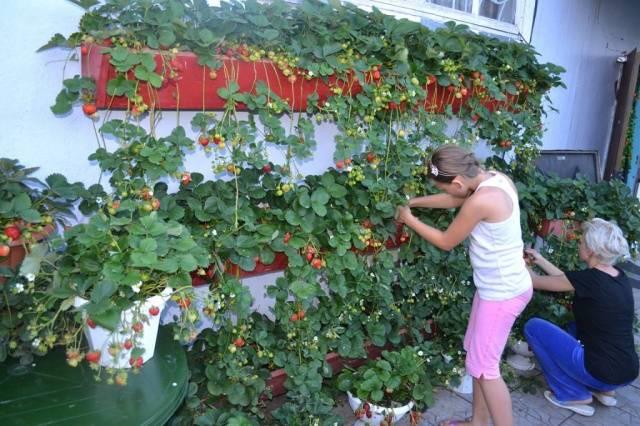
Choosing a covering material for strawberries
Black film and agrofibre provide similar results. The first material ensures the rapid ripening of strawberries, but requires a separate irrigation system. Therefore, black film is often recommended for planting crops in large areas. Agrofibre prevents the formation of condensation and the accumulation of slugs near bushes.
But this material contributes to the drying out of the soil, as a result of which the plant needs to be watered more often. Therefore, agrofibre is suitable for growing strawberries in small areas.
Choosing a place for strawberry beds
Areas with good illumination are suitable for planting crops. The plant is not recommended for growing in shaded areas. Lack of sunlight will lead to lower yields and reduced berry size. It also makes strawberries more sore.

The plant is recommended to be planted in soil with low acidity or neutral pH. It is optimal if the strawberry grows where legumes or cereals were previously planted. Plots where no plants have been grown for 2-3 years are also suitable. Planting strawberries next to nightshade crops is prohibited.
Site preparation
Strawberries are planted in pre-prepared soil. To do this, in the fall, you will need to add humus, rotted manure and compost (5-6 kilograms), as well as nitroammophoska (35 grams) to the soil (per square meter). Further, the soil is dug up and loosened. Weeds must be removed before planting the crop.
After spring comes, the bed should be re-loosened, breaking large clods of earth. Then you need to wait one week for the soil to settle.
Organization of beds and irrigation systems
The beds are recommended to be located from north to south. Such an organization will ensure uniform heating of the plants. The width of each bed (assuming a single-level planting) is 90 centimeters. Row spacing should be more than 65 centimeters.
It is recommended to raise each garden bed 10 centimeters above the plot, adding a sufficient amount of soil. This will provide better soil heating. In Finland, the beds are often additionally strengthened with a wooden frame, which will prevent soil subsidence. To do this, you need to put together boards up to 50 centimeters wide. Then the wooden frame is placed on the garden bed and fixed at the corners with high posts.
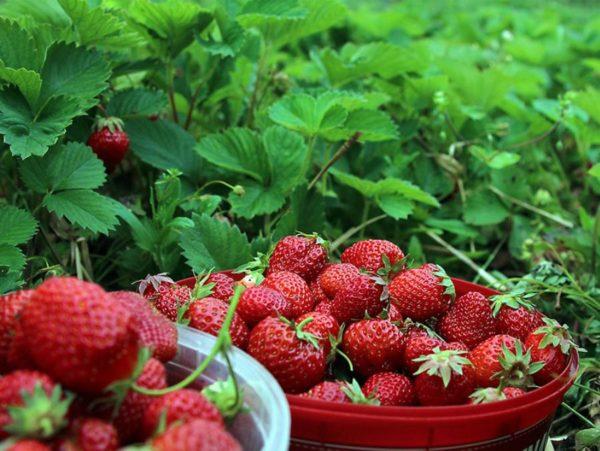
The second option is suitable for growing strawberries in the southern regions. Tall beds are better ventilated, which reduces the risk of infection with gray mold or powdery mildew.
After the formation of the beds, it is necessary to organize drip irrigation. This requires a garden hose of the correct length. On one side, you need to put a plug that will prevent water from flowing out. Further, small holes should be made along the entire length and the hose should be dug into the ground to a depth of 5-10 centimeters.
At the end, covering material is laid out on the soil. After that, the agrofibre or black film is stretched and fixed in the corners with stones or boards. On the surface of the material, holes with a diameter of 30 centimeters are marked, for strawberries in a checkerboard pattern (if the culture is planted in 2 rows) and with a step of 30-40 centimeters. You can cut through the film and agrofibre with a knife (preferably a clerical one) or with a pointed pipe.
We plant strawberry seedlings in the garden
Before planting, strawberry seedlings should be soaked for half an hour in a weak solution of potassium permanganate. Also, appropriate purchased products are suitable for disinfecting the plant. Strawberries are planted on a cloudy day or before dusk. This is necessary for the culture to take root.

The plant is planted in holes with a depth equal to the length of the root system. Pour 500 milliliters of water into each hole. After planting, cover the root system with soil, leaving the center of the outlet free. The plant is then watered again.
Care features
Strawberries love to be poured with warm water. In order to prevent the death of the plant, it is recommended to regularly treat the bushes from pests and remove yellowed or dried leaves.
Feeding strawberries
For the first time, fertilizers are applied in the spring, using a mixture of cow dung (1 part) and water (10 parts) or nitroammofoska (1 tablespoon) and water (10 liters). Pour one liter of the resulting composition under each bush.
The second dressing is applied after harvesting. For this, the following mixtures are suitable:
- 100 grams of ash and 10 liters of water;
- 2 tablespoons of nitrophosphate, a teaspoon of potassium sulfate and 10 liters of water;
- 2 tablespoons of potassium nitrate and 10 liters of water.
Under each bush, 500 milliliters of one of the described mixtures is applied. For the third time, strawberries are fed mullein with water in September.

Watering
The culture requires regular watering with warm water. In this case, it is necessary to avoid waterlogging (waterlogging) of the site.
Treatment against diseases and pests
In order to prevent infection, the culture is sprayed twice: in spring and autumn. To prevent diseases, strawberries are treated with a solution of 110 milliliters of Fitosporin M and 30 liters of water. In case of infection, it is recommended to spray the culture with a mixture of similar ingredients, taken in a 1:20 ratio. For every 10 square meters of land, 1 liter of such a solution will be required.





